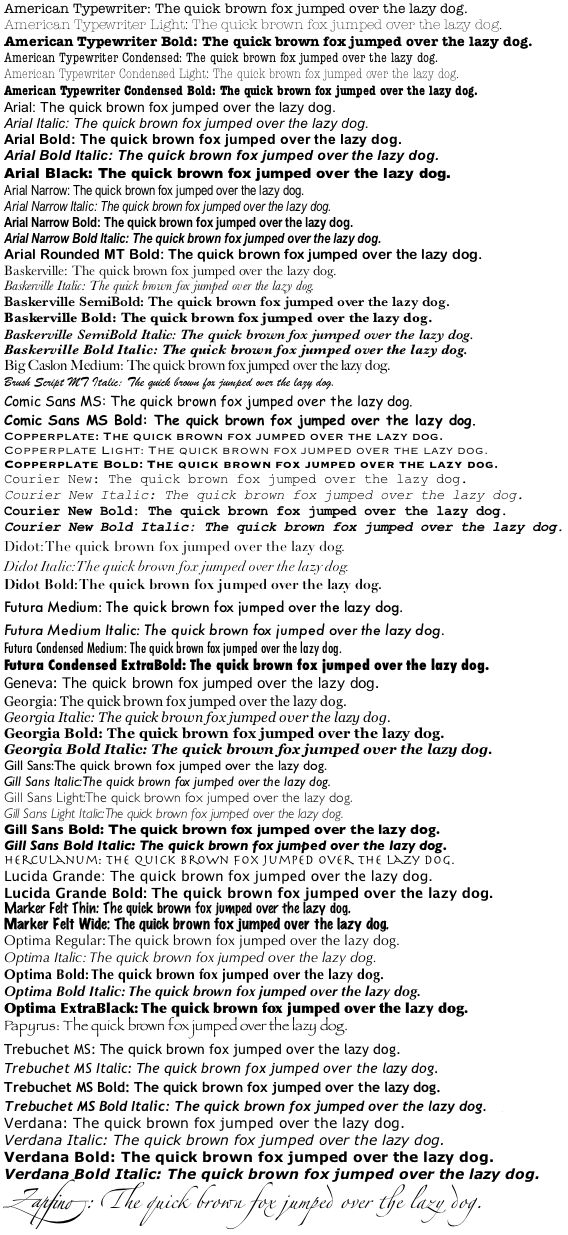List of typefaces included with macOS
 |macosx-allfonts|thumb]]|thumb]]
|macosx-allfonts|thumb]]|thumb]]
|Fonts-x|thumb|left]]|thumb|left]]
|Fonts-x2|thumb|left]]|thumb|left]] List of Typefaces Included with macOS
The macOS operating system, developed by Apple Inc., includes a variety of typefaces that have been bundled with the system over the years. These typefaces are utilized across the system, in Apple applications, and by third-party applications, providing a consistent and visually pleasing user experience. This article provides an overview of the typefaces included with macOS, highlighting their significance and usage.
System Typefaces[edit | edit source]
The system typefaces are those used by macOS for UI elements, such as menus, dialog boxes, and system alerts.
- San Francisco: Introduced in macOS El Capitan (10.11), San Francisco is the system typeface designed for maximum legibility on Apple’s displays. It comes in two variations: SF Pro for macOS and SF Compact for watchOS.
- Helvetica Neue: Before San Francisco, Helvetica Neue was the system font, starting from macOS Yosemite (10.10) until it was replaced.
- Lucida Grande: Served as the system font for macOS from its inception in Mac OS X Cheetah (10.0) until Mavericks (10.9).
Serif Typefaces[edit | edit source]
Serif typefaces, known for their decorative feet at the end of letter strokes, are often used in more traditional or formal contexts.
- Times New Roman: A classic serif typeface widely used in book publishing and legal documents.
- Palatino: A robust serif typeface that is commonly used in both body text and headings.
Sans-serif Typefaces[edit | edit source]
Sans-serif typefaces, characterized by the absence of serifs, offer a more modern and clean aesthetic.
- Arial: A widely used sans-serif typeface that is often employed for body text and headings alike.
- Verdana: Known for its high readability at small sizes, making it a popular choice for web content.
Monospaced Typefaces[edit | edit source]
Monospaced typefaces, where each character occupies the same horizontal space, are frequently used in coding environments.
- Monaco: A classic monospaced typeface that was the default for the Terminal app before being supplanted by Menlo.
- Menlo: Introduced in macOS Snow Leopard (10.6), Menlo is now the default typeface for the Terminal app, replacing Monaco.
Script and Decorative Typefaces[edit | edit source]
macOS also includes a variety of script and decorative typefaces, which are used sparingly for artistic and embellishment purposes.
- Brush Script: A script typeface that mimics the look of handwriting done with a brush and ink.
- Comic Sans MS: A casual script typeface that has become infamous for its overuse in inappropriate contexts.
Non-Latin Typefaces[edit | edit source]
macOS supports a wide range of languages and scripts, including non-Latin typefaces for languages such as Arabic, Chinese, Hebrew, and more.
- Heiti SC: A simplified Chinese typeface that offers a modern and clean look.
- Arial Hebrew: A typeface designed for the Hebrew script, used widely in macOS for Hebrew language support.
Conclusion[edit | edit source]
The typefaces included with macOS are an essential part of the user experience, offering both functionality and aesthetic appeal. Apple has carefully curated this collection to ensure readability, accessibility, and stylistic variety, catering to a wide range of design needs and preferences.
Navigation: Wellness - Encyclopedia - Health topics - Disease Index - Drugs - World Directory - Gray's Anatomy - Keto diet - Recipes
Search WikiMD
Ad.Tired of being Overweight? Try W8MD's physician weight loss program.
Semaglutide (Ozempic / Wegovy and Tirzepatide (Mounjaro / Zepbound) available.
Advertise on WikiMD
WikiMD is not a substitute for professional medical advice. See full disclaimer.
Credits:Most images are courtesy of Wikimedia commons, and templates Wikipedia, licensed under CC BY SA or similar.Contributors: Prab R. Tumpati, MD


